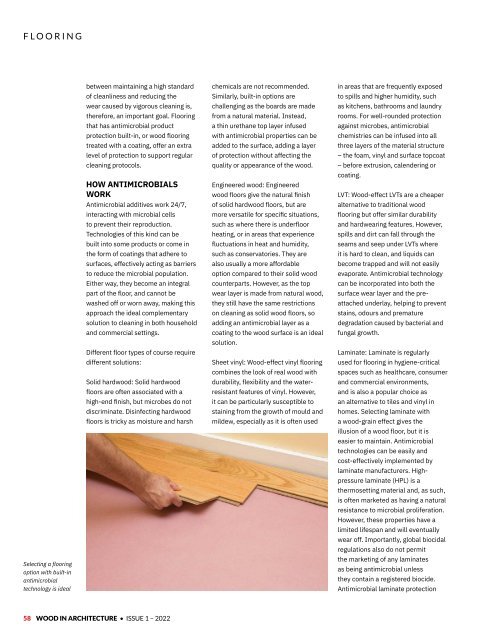Wood In Architecture Issue 1, 2022
First published in 2017, Wood in Architecture (WIA) is a bi-annual trade magazine devoted to the international timber construction sector. The newest addition to the Panels & Furniture Group of wood magazines, WIA features in-depth insights to the latest industry news, incredible projects and leading trade events. WIA is an advocate for timber as a material of choice for today’s built environment, and is the perfect source of inspiration for architects, builders, engineers and interior designers across the globe.
First published in 2017, Wood in Architecture (WIA) is a bi-annual trade magazine devoted to the international timber construction sector. The newest addition to the Panels & Furniture Group of wood magazines, WIA features in-depth insights to the latest industry news, incredible projects and leading trade events. WIA is an advocate for timber as a material of choice for today’s built environment, and is the perfect source of inspiration for architects, builders, engineers and interior designers across the globe.
You also want an ePaper? Increase the reach of your titles
YUMPU automatically turns print PDFs into web optimized ePapers that Google loves.
FLOORING<br />
Selecting a flooring<br />
option with built-in<br />
antimicrobial<br />
technology is ideal<br />
between maintaining a high standard<br />
of cleanliness and reducing the<br />
wear caused by vigorous cleaning is,<br />
therefore, an important goal. Flooring<br />
that has antimicrobial product<br />
protection built-in, or wood flooring<br />
treated with a coating, offer an extra<br />
level of protection to support regular<br />
cleaning protocols.<br />
HOW ANTIMICROBIALS<br />
WORK<br />
Antimicrobial additives work 24/7,<br />
interacting with microbial cells<br />
to prevent their reproduction.<br />
Technologies of this kind can be<br />
built into some products or come in<br />
the form of coatings that adhere to<br />
surfaces, effectively acting as barriers<br />
to reduce the microbial population.<br />
Either way, they become an integral<br />
part of the floor, and cannot be<br />
washed off or worn away, making this<br />
approach the ideal complementary<br />
solution to cleaning in both household<br />
and commercial settings.<br />
Different floor types of course require<br />
different solutions:<br />
Solid hardwood: Solid hardwood<br />
floors are often associated with a<br />
high-end finish, but microbes do not<br />
discriminate. Disinfecting hardwood<br />
floors is tricky as moisture and harsh<br />
chemicals are not recommended.<br />
Similarly, built-in options are<br />
challenging as the boards are made<br />
from a natural material. <strong>In</strong>stead,<br />
a thin urethane top layer infused<br />
with antimicrobial properties can be<br />
added to the surface, adding a layer<br />
of protection without affecting the<br />
quality or appearance of the wood.<br />
Engineered wood: Engineered<br />
wood floors give the natural finish<br />
of solid hardwood floors, but are<br />
more versatile for specific situations,<br />
such as where there is underfloor<br />
heating, or in areas that experience<br />
fluctuations in heat and humidity,<br />
such as conservatories. They are<br />
also usually a more affordable<br />
option compared to their solid wood<br />
counterparts. However, as the top<br />
wear layer is made from natural wood,<br />
they still have the same restrictions<br />
on cleaning as solid wood floors, so<br />
adding an antimicrobial layer as a<br />
coating to the wood surface is an ideal<br />
solution.<br />
Sheet vinyl: <strong>Wood</strong>-effect vinyl flooring<br />
combines the look of real wood with<br />
durability, flexibility and the waterresistant<br />
features of vinyl. However,<br />
it can be particularly susceptible to<br />
staining from the growth of mould and<br />
mildew, especially as it is often used<br />
in areas that are frequently exposed<br />
to spills and higher humidity, such<br />
as kitchens, bathrooms and laundry<br />
rooms. For well-rounded protection<br />
against microbes, antimicrobial<br />
chemistries can be infused into all<br />
three layers of the material structure<br />
– the foam, vinyl and surface topcoat<br />
– before extrusion, calendering or<br />
coating.<br />
LVT: <strong>Wood</strong>-effect LVTs are a cheaper<br />
alternative to traditional wood<br />
flooring but offer similar durability<br />
and hardwearing features. However,<br />
spills and dirt can fall through the<br />
seams and seep under LVTs where<br />
it is hard to clean, and liquids can<br />
become trapped and will not easily<br />
evaporate. Antimicrobial technology<br />
can be incorporated into both the<br />
surface wear layer and the preattached<br />
underlay, helping to prevent<br />
stains, odours and premature<br />
degradation caused by bacterial and<br />
fungal growth.<br />
Laminate: Laminate is regularly<br />
used for flooring in hygiene-critical<br />
spaces such as healthcare, consumer<br />
and commercial environments,<br />
and is also a popular choice as<br />
an alternative to tiles and vinyl in<br />
homes. Selecting laminate with<br />
a wood-grain effect gives the<br />
illusion of a wood floor, but it is<br />
easier to maintain. Antimicrobial<br />
technologies can be easily and<br />
cost-effectively implemented by<br />
laminate manufacturers. Highpressure<br />
laminate (HPL) is a<br />
thermosetting material and, as such,<br />
is often marketed as having a natural<br />
resistance to microbial proliferation.<br />
However, these properties have a<br />
limited lifespan and will eventually<br />
wear off. Importantly, global biocidal<br />
regulations also do not permit<br />
the marketing of any laminates<br />
as being antimicrobial unless<br />
they contain a registered biocide.<br />
Antimicrobial laminate protection<br />
58 WOOD IN ARCHITECTURE • ISSUE 1 – <strong>2022</strong>


















